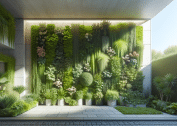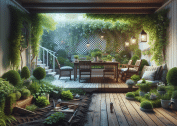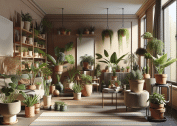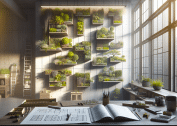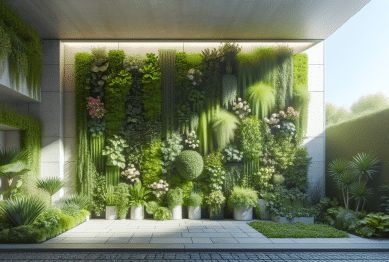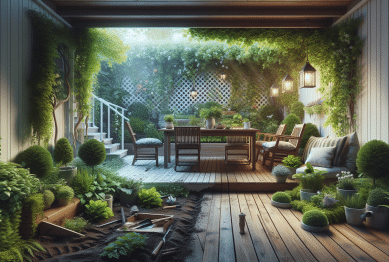Home offices have evolved from makeshift desks into essential, purpose-built spaces that support work, wellness, and personal expression. In 2025, design trends emphasize functionality, environmental harmony, and subtle technology to craft spaces that feel both grounded and energizing. This article highlights key directions—such as moody color palettes, biophilic design, smart tech, flexible layouts, sound-conscious setups, wellness features, and personal touches—and walks you through steps to design a home office that’s both inviting and productive.
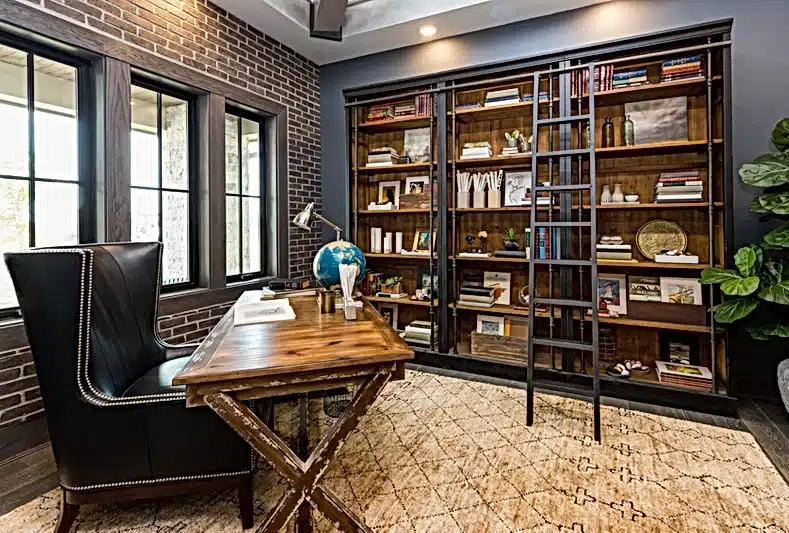
Section 1: What’s Shaping Home Office Design in 2025?
Emerging Trends to Know
- Moody, Saturated Color Palettes
Designers are moving away from sterile whites. Rich colors like sage green, terracotta, and burgundy are gaining ground because they feel simultaneously professional and warm—a welcomed shift in home office decor. These hues can energize without overstimulation. - Integrated Technology That Blends In
The trend is toward technology that works quietly: smart lighting, hands-free assistants, and concealed charging systems. These features keep the workspace streamlined and distraction-free. - Biophilic Design for Focus and Well-being
Bringing nature indoors—through plants, textures, and natural light—not only enhances mood but also improves focus, stress recovery, and creative thinking. A well-regarded study links such design to higher productivity, especially in environments where people feel connected to nature. - Flexible and Multifunctional Layouts
Home offices increasingly double as relaxation or wellness spaces. Furniture that’s easy to reconfigure, zones that serve multiple purposes, and spaces that shift between focused work and rest help this flexibility. - Wellness-Centered Spaces
There’s growing interest in ergonomic setups, air quality devices, and mini wellness corners—like meditation nooks or areas designed for stretching—to support sustained performance and well-being at home. - Silent, Focus-Friendly Environments (Acoustics)
Noise can derail concentration. Solutions like sound masking, acoustic partitions, and quiet zones help create calm spaces for deep work.
Section 2: Why These Trends Work
1. Psychological Lift and Energy
Moody color tones create a sophisticated ambiance that energizes without feeling too clinical or neutral.
2. Less Visual Clutter, More Flow
Smart tech hidden in plain sight means fewer distractions and more mental clarity during work.
3. Nature Enables Focus and Boosts Mood
Biophilic design helps occupants feel emotionally refreshed, reducing stress and improving cognitive performance. One 2024 study found that exposure to nature—even indirectly—drives vigor, which then enhances job and overall well-being. Additional findings show that multisensory natural elements can enhance working memory and mood.
4. Flexibility Matches Life’s Rhythms
Home and work life blend more than ever. Flexible design adapts to different needs—check-in, check-out, stretch, recharge—keeping the space relevant all day.
5. Wellness Design Supports Long-Term Productivity
Integrating healthy lighting, ergonomic furniture, and peaceful zones helps sustain long-term focus and comfort.
6. Quiet Zones Protect Attention
Acoustic solutions and smart scheduling tools (like focus modes in apps) help safeguard productivity.
Section 3: Step-by-Step Guide to Build Your Home Office
1: Choose Your Color Tone
- Pick one bold, saturated hue—like sage green, burgundy, or terracotta—for an accent wall or key decor pieces.
- Pair with neutral textures to balance boldness—for instance, wooden furniture or a neutral rug.
- Ensure lighting (natural or artificial) showcases the color well—blue-toned light may mute terracotta, while warm LEDs can enhance it.
2: Bring Nature In
- Plants: Start with two to three low-maintenance varieties like snake plants or pothos.
- Textural Elements: Add wooden desks, tactile fabric, or stone details.
- Natural Light: Locate your desk near a window. If that’s not possible, use daylight-balanced LED lighting.
- Multisensory Triggers: Consider a small fountain or nature soundtrack, but keep them minimal—too many stimuli can distract.
3: Blend Technology Smoothly
- Use smart bulbs that shift temperature to match the time of day.
- Hide wires with cable trays or integrated desk inlays. Add wireless charging pads to surface areas.
- Use voice assistants for simple tasks (e.g., setting timers or adjusting music).
- Keep screens glare-free with diffused desk lamps and screen filters.
4: Build Flexible Zones
- Divide your room into zones:
- A desk for focused work
- A comfortable seat or corner for reading/thinking
- A spot for stretching or short breaks—like a yoga mat or soft rug
- Use furniture (like open shelving or rugs) and lighting to visually separate the zones.
5: Incorporate Wellness Features
- Choose an ergonomic chair with lumbar support or a sit–stand desk.
- Add air-purifying plants or an air quality monitor.
- Keep a small foam roller or yoga strap nearby.
- Dress the lighting to support your circadian rhythm—cool-toned light in the day, warmer tones in late afternoon.
6: Manage Sound Thoughtfully
- If ambient noise is an issue, use a small sound diffuser or speaker with gentle nature sounds.
- If possible, install acoustic panels or add soft textiles (e.g., curtains, rugs) to muffle noise.
- Use “Do Not Disturb” modes or time blocks in your calendars to minimize interruptions.
7: Add Personal, Purposeful Decor
- Choose one statement art piece that reflects your taste and matches your color palette.
- Display personal items or mementos on a neat shelf or desk—not so many that they clutter.
- Pick textures or small decor items that reinforce the natural theme—like woven baskets or a clay mug.
8: Evaluate and Refresh Regularly
- After two weeks, assess what’s working. Adjust lighting, move a plant, try a new rug. Even small tweaks can have a big impact.
- Consider seasonal changes—add a cozier throw or layer lighting as days shorten.
Section 4: Why Each Step Adds Value
- Color Choices: Bold tones help balance energy and professionalism.
- Biophilic Elements: Support focus, mood, and mental clarity.
- Integrated Tech: Minimizes distractions, enhances usability.
- Zoned Layouts: Add versatility by combining work and self-care.
- Wellness Enhancements: Sustain long-term comfort and productivity.
- Sound Design: Protect your attention and reduce fatigue.
- Personal Decor: Builds emotional comfort and connection to the space.
- Adaptability: Keeps the setup fresh, responsive, and aligned with you.
Conclusion
Designing a home office now means blending productivity with peace, tech with tact, and function with feeling. The 2025 trends—rich colors, flowing tech, natural textures, flexible zones, wellness, and quiet—are more than aesthetic preferences: they’re tools to shape your mindset, support your output, and preserve your balance. By layering these elements consciously, you create a workspace that reflects your needs, uplifts your spirit, and accepts change.
Would you like help sourcing eco-friendly furniture, layouts tailored to your room size, or a mini mood board for your palette?ombinations, or creating a layout plan!
References
- The Spruce. (2025, January 8). Home office trends for 2025. The Spruce. Available at: https://www.thespruce.com (Accessed: 12 August 2025).
- Decorilla. (2025, January 3). Office design trends 2025: Stylish & functional ideas. Decorilla.
Available at: https://www.decorilla.com (Accessed: 12 August 2025). - Office Principles. (2025, January 10). Office design trends for 2025. Office Principles.
Available at: https://officeprinciples.com (Accessed: 12 August 2025).


